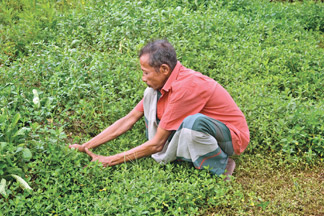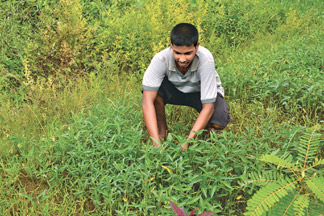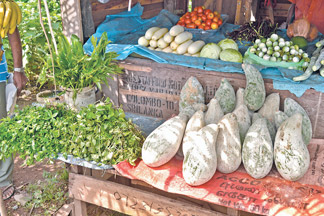|
Largest plantation in Kahatawela:
Green leaves enrich and enhance your diet
By Ananda KANNANGARA
Would anybody believe that a bundle of Kan-kun leaves, which is sold
at a vegetable stall for Rs. 20, was purchased by a person for Rs. 150?
This incident was witnessed even by a police officer who was patrolling
the Manning Market, Pettah last week.
|

Padmasena reaps the Mukunuwenna harvest |
A foreign tour group comprising 10 members was walking in the city in
the evening with their pet ape, given to them by a snake charmer who was
operating near a popular tourist hotel in Kollupitiya. The tour group
had stopped at the Manning Market for awhile to buy some bananas for the
animal.
The foreigners were not accompanied by a local guide and were not
familiar with the prices of bananas.
While the group was choosing ripe fruit, the ape grabbed a bundle of
Kan-kun leaves and started munching. The Kan-kun seller did not show any
anger over the incident. The foreigner took out her purse and inquired
from the trader about the price of Kan-kun. He promptly answered in
English, Madam, it is not too much, it costs only Rs. 150. The foreign
woman, unaware of the actual price of the Kan-kun bundle, offered two
one hundred rupee notes and went away. On seeing the incident , the
Police officer advised the trader to refrain from cheating foreigners or
anybody else in such a manner.
Largest plantation
This story of the Kan-kun bundle reminded me of my recent visit to a
large green leaves cultivation at Kahatawela in the Kalutara district.
The Kahatawela green leaves cultivation zone is considered the largest
such plantation, comprising over 1,000 acres.
The zone is about 30 kilometres from the town of Kalutara, which
needs no introduction to anybody travelling to the South from Colombo,
for its huge dagoba is synonymous with the city. Kahatawela is famous
for green leaves. Even foreigners on their way Down South visit this
village to see the beauty of these large green leaves cultivations.
Green leaves are also called `Keera' in Sinhala. According to
Agriculture Department statistics, 80 percent of the green leaves supply
for people in Colombo and suburban areas are produced by farmers in the
Kalutara district.

Reaping Kan-kun

A vegetable stall with green leaves |
The statistics also reveal that the main green leaves such as
Mukunuwenna, Kan-kun, Thampala and Sarana are cultivated in over 1,500
acres in Kahatawela, Anguruwatota and Welmilla in the Kalutara district.
Green leaves or Keera are popular as vegetables among locals,
especially those who live in Colombo and suburban areas. Sri Lankan
green leaves are also sold in many Middle Eastern countries.
A senior SriLankan Airlines official said it takes only a few hours
to send fresh green leaves from Sri Lanka to Dubai. Unlike many other
vegetables, there are no English names for green leaves and they are
known by their Sinhala names.
High land prices
The Agriculture Department said that green leaves were also
cultivated at Nawala in the Colombo district over 100 years ago. Acres
of land near the Diyawanna Oya were used by farmers to cultivate popular
green leaves such as Mukunuwenna, Kan-kun and Thampala.
The leaves were provided to the residents of Colombo, especially in
Bambalapitiya and Kollupitiya. However, with the value of land in these
areas going up during the 1970s, these cultivable lands were used to
construct housing complexes, business enterprises and industries. People
in Nawala even today say that Kan-kun plants could be seen on the banks
of the Diyawanna Oya and Nawala lake running up to Wellawatta then.
The Sunday Observer last week visited several green leaves
cultivations in the Kalutara district. Among them, the Kahatawela
cultivation seemed to be the best and most prominent with over 1,000
acres.
A long-standing cultivator, 60year-old Padmasena Perera said he has
been in the green leaves cultivation industry for the past 20 years. I
have less than five acres to cultivate green leaves and I enjoy my
vocation. I grow several varieties of green leaves such as Mukunuwenna,
Kan-kun, Sarana and Thampala and earn about Rs. 20,000 per month.
He said he sells a bundle of Kan-kun or Mukunuwenna for Rs. 12 each
while a vegetable seller would earn Rs. 25 from a bundle. He said the
little income was sufficient for him to make ends meet with his wife and
two sons.
Good harvest
Padmasena said he uses No-1 Keta fertiliser and some urea without
which it is difficult to yield a good harvest.
He said over 300 families in the area depend on green leaves
cultivations (keera) and hundreds of bare land are still available at
Kahatawela. Although these lands are cultivable, the owners who are
wealthy people in the area are not properly using them, he said.
Padmasena proposed the area Divisional Secretariats to grant such lands
on lease to persons who are willing to cultivate them.
He said about four lorry loads of green leaves leave Kahatawela to
Colombo everyday. I have heard that our leaves are also exported to
foreign countries such as Dubai, Rome and Australia, he said.
He also proposed to the Agriculture Department to start a regular
crop collecting system from Kahatawela, so that farmers could sell their
harvest straightaway without employing middlemen.
Padmasena also requested the Government to expedite the farmers
pension scheme since not a single farmer in his area has so far received
a pension as promised by the Agrarian Service several years ago. I hope
at least President Mahinda Rajapaksa will listen to our grievances and
expedite the pension scheme, he said. He said all farmers in Kahatawela
have already paid their monthly contributions to be members of the
pension scheme.
A long-standing 72-year-old green leaves farmer K.R. Piyasena said he
started cultivating green leaves at the age of 30 and earns about Rs.
40,000 a month from the business.
He said in addition to green leaves , he grows Nivithi (spinach),
string beans, dambala, bitter gourd, snake gourd, manioc, yams, cabbage
and radish. Piyasena also requested the Agrarian Service authorities to
expedite the farmers pension scheme, considering the high cost of living
in the country. |

